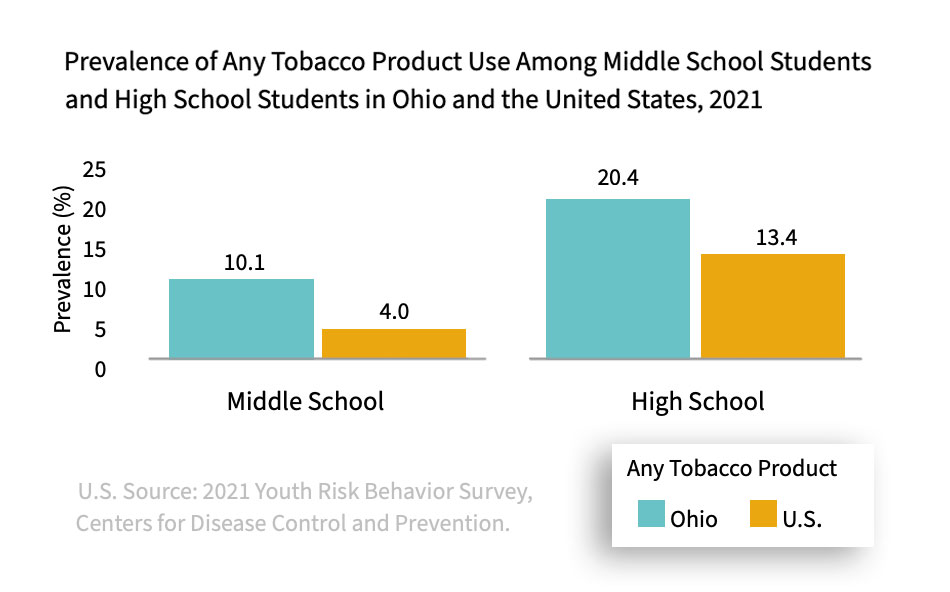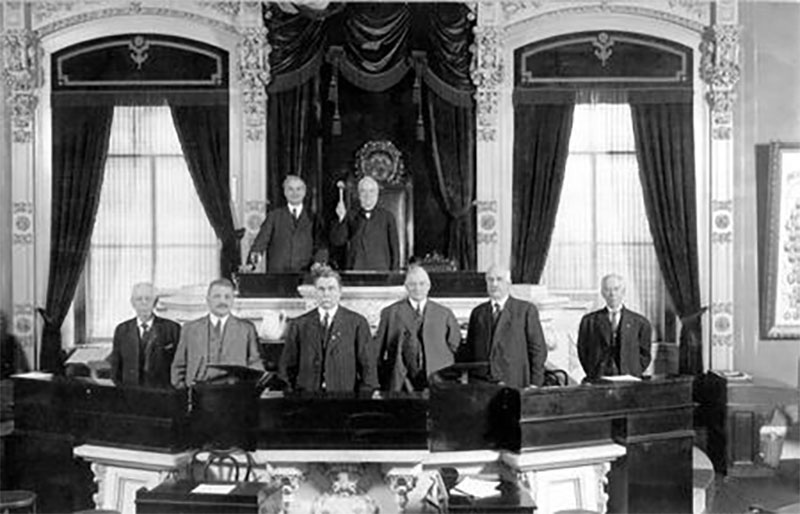Cotton Candy Tobacco, the Canton Test, and the Importance of Home Rule in Ohio
September 18, 2025
Check out our City Solutions podcast episode on home rule here:
Products like cotton candy flavored tobacco are marketed to children and have been driving a spike in tobacco use among teens across Ohio.
Schools throughout the state, in cities and small towns, have reported a significant increase in teen vaping. This has promoted the installation of vape detectors in school bathrooms and other counter measures to mitigate the harmful, lifelong impacts of tobacco addiction in young adults.

Cities and other local governments have adopted a range of local regulations to help protect children and youth from tobacco. The City of Heath in Licking County, for example, prohibits the local marketing of tobacco vaping products that are not authorized by the U.S. Food and Drug Administration (FDA). Some cities ban smoking in public parks and on public property.
In 2022, to combat the public health threats of tobacco among youth, the City of Columbus exercised its constitutional home rule authority to enact an ordinance banning the sale of flavored tobacco in the city limits.
Two days later, the Ohio state legislature, which disagreed with Columbus’ approach to protect young adults from this health risk, reacted by passing a law prohibiting all cities in Ohio from regulating tobacco.
Governor Mike DeWine, recognizing the public health threat to young people from flavored tobacco, vetoed this bill. Five months later, in July of 2023, the legislature again passed a similar preemption on regulating tobacco and Gov. DeWine vetoed this bill for the second time. However, in December of 2023, the legislature overroad the Governor’s second veto and enacted R.C. 9.681.
The fight over flavored tobacco wasn’t over. Following enactment of this law, cities led by both Republican and Democratic mayors joined together to fight for their right to protect the health and welfare of their communities and the constitutionally protected rights set forth in the Ohio Constitution’s home rule provision.
Now, business interests and the Ohio Attorney General are asking for the Ohio Supreme Court to take up this case after the lower courts ruled in favor of Ohio’s constitutional right to home rule. Even more concerning, however, is the Attorney General’s argument in its memorandum in support of jurisdiction to the Ohio Supreme Court that the Court should overrule the Canton Test, as set forth in the Ohio Supreme Court’s 2002 decision in Canton v. State, and throw out decades of court precedent guiding how the state and local governments should understand and apply home rule.
If the court were to do this, it would be the equivalent of a nuclear option for home rule rights for municipalities in Ohio.
To learn more about home rule, why it’s important, and the potential implications of getting rid of the Canton Test, read more below.
What is Home Rule and Why is it Important?
Why is Home Rule in the Ohio Constitution?
What Could Happen if the Canton Test Was Overruled?
What is Home Rule and Why is it Important?

In 1912, Ohio voters approved an amendment to the state constitution to give municipalities the right of home rule.
Found in Article XVIII, home rule allows cities and villages to govern themselves on local matters through charters and ordinances, rather than relying solely on the Ohio General Assembly. Home rule has two main components:
- Local Self-Government – communities can decide how to structure their government, manage finances, and organize local elections.
- Police Powers – municipalities may adopt regulations to protect health, safety, and general welfare (such as zoning, building codes, or traffic rules), as long as they do not conflict with “general laws” of the state.
This authority matters because Ohio is a diverse state. What works for Cleveland or Columbus may not fit a Cadiz or Coshocton.
Home rule ensures that local governments can craft policies suited to their residents, respond quickly to problems, and preserve their unique identity. It also strengthens accountability: decisions about schools, safety, and services are made by officials directly answerable to the community.
At the same time, home rule is limited. When local ordinances conflict with a statewide “general law,” state law prevails. The Ohio Supreme Court uses the Canton v. State test to decide whether a statute qualifies as a general law.
In practice, home rule reflects a balance between local flexibility and statewide uniformity. It empowers communities to innovate and govern themselves, while preserving the state’s ability to ensure consistency on broader issues.
More than a century after the adoption of the Ohio Constitution’s home rule provision, home rule remains vital to local democracy in Ohio.
Why is Home Rule in the Ohio Constitution?
Recognizing that one-size-fits-all doesn’t always work for Ohio’s unique array of diverse community types, voters approved the Ohio Constitution’s Home Rule amendment in 1912 by 58 percent of the vote.
This amendment was also a response to undue influence on state lawmakers by powerful, private sector lobbying interests.
The constitutional convention that proposed this amendment also recognized that a concentration of power in the state capital made it easier for special interests to influence policy decisions across the state, even when those interests may have direct, adverse impacts on the health and welfare of local residents.
By giving municipalities the power to adopt charters and regulate their own local affairs, Ohioans approved the home rule amendment to vest in their local elected officials the power to implement policies that impact and benefit their communities and don’t directly conflict with state law.
What is the Canton Test?
The Ohio Supreme Court’s decision in Canton v. State, 2002-Ohio-2005, is central to Ohio’s home rule doctrine. It established a four-part “general law” test that is used to decide whether state statutes override municipal ordinances. The Canton Test asks “whether (1) the ordinance is an exercise of the police power, rather than of local self-government, (2) the statute is a general law, and (3) the ordinance is in conflict with the statute.”
To determine whether a state statute qualifies as “general law,” under the Canton Test courts look at:
- Comprehensive statewide enactment: The statute must be part of a broader, coordinated regulatory scheme, not just a one-off law aimed at a single local issue.
- Uniform application across the state: The law must apply equally to all parts of Ohio, not single out particular cities, villages, or regions.
- Sets forth police, sanitary, or similar welfare regulations (not just restricts local power): A valid “general law” must actually regulate people’s behavior or protect public welfare, not simply strip municipalities of authority. For example, a state law banning texting while driving regulates citizens’ conduct is valid. In contrast, a law that merely says, “Cities cannot pass ordinances about texting and driving,” without setting its own statewide rule, would likely fail this prong.
- Prescribes a rule of conduct for citizens generally: The statute must tell citizens what they can or cannot do, not just dictate how local governments must act. Another example: A law requiring drivers to wear seat belts tells individuals what to do—rule of conduct. A law saying, “Municipalities shall not regulate seat belts,” would not meet this requirement.
This test was designed to protect meaningful local authority: only when the state enacts broad, uniform rules governing citizens can it override municipal ordinances. In practice, courts interpret these prongs differently, which is why home rule battles in Ohio continue.
What Could Happen if the Canton Test Was Overruled?
In a filing in the Columbus tobacco regulation case, the State of Ohio is asking the Ohio Supreme Court to overrule its 2002 decision in Canton v. State, the case that created the Canton Test that guides how local governments and the State of Ohio should approach determinations of home rule authority. This request to the Court to review and reconsider its 23 year old precedent in Canton v. State is concerning because to throw out the legal framework that guides cities and the state in how to determine the boundaries of home rule authority versus state “general laws” would essentially annihilate the practical impact of municipalities’ home rule authority.
Overruling the Canton Test without replacing it with another framework – as the State of Ohio is urging – would create a system whereby the state legislature would have unchecked authority to decide whether it wanted to allow municipalities to legislate on any topic. Without clear authority to regulate under their “police powers,” as laid out in Article XVIII, Section 7, municipalities would essentially lose their right to local self-governance. Thus, the intent of the Ohio Constitution and the Ohio voters who approved the home rule provision in 1912 would be thwarted.
There is no doubt that when charter municipalities and the State of Ohio disagree on policy issues, there will sometimes be disputes as to whether cities should be able to regulate issues and to what extent local laws may conflict with state laws. To overrule the only current framework for resolving disputes, however, in a way that would weigh all disputes in favor of the state, contravenes the spirit and purpose of home rule in Ohio. The Ohio Mayors Alliance, as a bipartisan coalition of mayors in a diverse array of Ohio cities in suburbs, has long advocated for bipartisan solutions and cooperation that honors local innovation while facilitating statewide collaboration.
